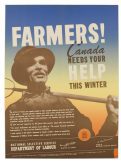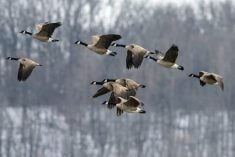He has 600 acres to combine, but this might be the best year ever for soybeans on Albert Turski’s farm.
So far, Turski has combined 900 acres of beans on his farm near La Salle, Man., and certain fields have yielded 60 bu. per acre.
“I think we’re averaging around 50 right now,” he said Friday morning.
Later than usual planting this spring and three weeks of cool weather this summer have pushed back Manitoba’s soybean harvest, yet many farmers still report above average yields.
In late September, Manitoba Agriculture said soybean yields range from 35 to 50 bushels per acre in central and eastern parts of the province.
Read Also

Women who fed a nation
More than 40,000 young women supported the war effort between the 1940s and early 1950s, helping grow and harvest crops amid labour shortages. They were called Farmerettes.
In its estimates of principal field crop production, Statistics Canada said today that soybean yields in Manitoba would average 33.1 bu. per acre, down from 35.4 bu per acre in 2012.
Randy Froese, who grows more than 3,500 acres of beans near Winkler, Man., had 2,000 acres to combine as of Oct. 4.
“This is not typical. By now we would usually have three-quarters of the soybeans off,” he said. “Generally, we can do about 250 to 300 acres a day. But because the days are so short (now) we’re only getting about 200 acres per day.”
Froese’s crop is yielding 38 to 45 bu. per acre, on average, with a few varieties yielding above 50.
Terry Buss, Manitoba Agriculture crop production adviser in Beausejour, Man., said most producers are pleased with soybean yields this fall.
“Some of the high yields (last year) were really high. People were breaking the high 50s and even into the 60s…. I haven’t heard news like that yet, but I have heard people say it’s above average.”
When daily high temperatures struggled to top 20 C in late July and early August, soybean and corn growers in Manitoba grew concerned about crop maturity and potential yields.
At the time, Turski thought he might be combining in the snow.
“We grow corn also and we didn’t think we would harvest corn until November,” he said, which is why he’s pleasantly surprised by his soybean yields. “(It’s) very shocking.”
Buss said the resilience of soybeans in hot, dry, wet or cool conditions, is astounding.
“While they like higher temperatures than, say, a canola or a cereal… soy is still more flexible than something like a corn,” he said. “The soybean plant is quite adaptive. When we went through that cool period… you really saw the beans stop growing…. But when the temperatures changed (in August) and things got more hospitable for them, they have a great deal of ability to make up for lost time.”















